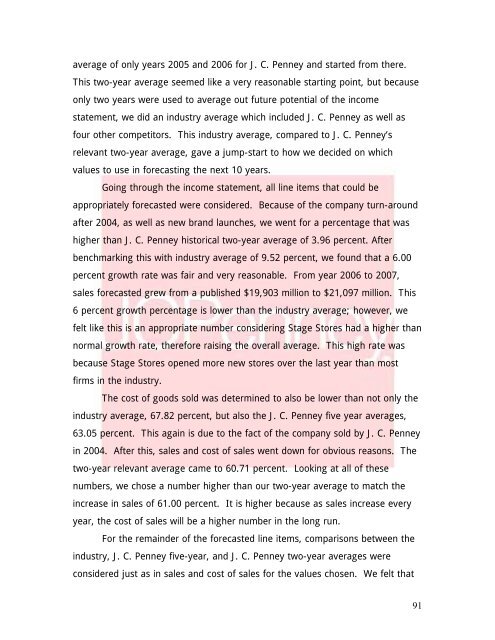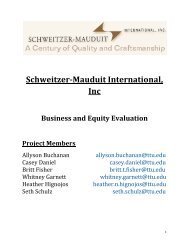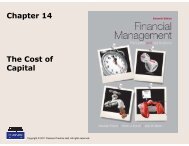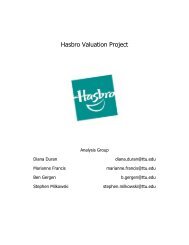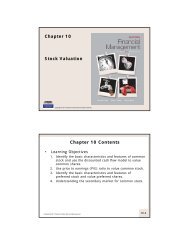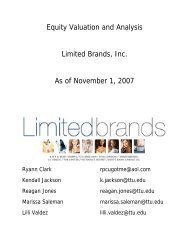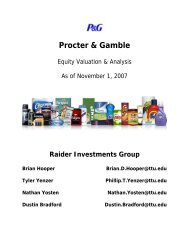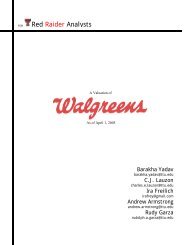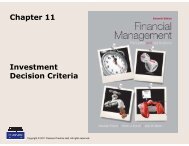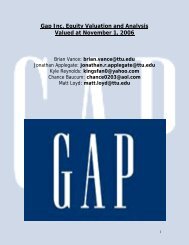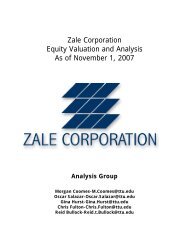J. C. Penney Company, Inc. Equity Valuation and Analysis As of ...
J. C. Penney Company, Inc. Equity Valuation and Analysis As of ...
J. C. Penney Company, Inc. Equity Valuation and Analysis As of ...
Create successful ePaper yourself
Turn your PDF publications into a flip-book with our unique Google optimized e-Paper software.
average <strong>of</strong> only years 2005 <strong>and</strong> 2006 for J. C. <strong>Penney</strong> <strong>and</strong> started from there.This two-year average seemed like a very reasonable starting point, but becauseonly two years were used to average out future potential <strong>of</strong> the incomestatement, we did an industry average which included J. C. <strong>Penney</strong> as well asfour other competitors. This industry average, compared to J. C. <strong>Penney</strong>’srelevant two-year average, gave a jump-start to how we decided on whichvalues to use in forecasting the next 10 years.Going through the income statement, all line items that could beappropriately forecasted were considered. Because <strong>of</strong> the company turn-aroundafter 2004, as well as new br<strong>and</strong> launches, we went for a percentage that washigher than J. C. <strong>Penney</strong> historical two-year average <strong>of</strong> 3.96 percent. Afterbenchmarking this with industry average <strong>of</strong> 9.52 percent, we found that a 6.00percent growth rate was fair <strong>and</strong> very reasonable. From year 2006 to 2007,sales forecasted grew from a published $19,903 million to $21,097 million. This6 percent growth percentage is lower than the industry average; however, wefelt like this is an appropriate number considering Stage Stores had a higher thannormal growth rate, therefore raising the overall average. This high rate wasbecause Stage Stores opened more new stores over the last year than mostfirms in the industry.The cost <strong>of</strong> goods sold was determined to also be lower than not only theindustry average, 67.82 percent, but also the J. C. <strong>Penney</strong> five year averages,63.05 percent. This again is due to the fact <strong>of</strong> the company sold by J. C. <strong>Penney</strong>in 2004. After this, sales <strong>and</strong> cost <strong>of</strong> sales went down for obvious reasons. Thetwo-year relevant average came to 60.71 percent. Looking at all <strong>of</strong> thesenumbers, we chose a number higher than our two-year average to match theincrease in sales <strong>of</strong> 61.00 percent. It is higher because as sales increase everyyear, the cost <strong>of</strong> sales will be a higher number in the long run.For the remainder <strong>of</strong> the forecasted line items, comparisons between theindustry, J. C. <strong>Penney</strong> five-year, <strong>and</strong> J. C. <strong>Penney</strong> two-year averages wereconsidered just as in sales <strong>and</strong> cost <strong>of</strong> sales for the values chosen. We felt that91


